Adoption and Utilization of Cactus Pear in South Asia—Smallholder Farmers’ Perceptions
Abstract
:1. Introduction
2. Materials and Methods
2.1. Study Area
2.2. Questionnaire Design
2.3. Data Analysis
3. Results
3.1. Profile of Respondent Households
3.2. Non-Adopters, Potential Adopters and Actual Adopters
3.3. Non-Adopter Farmers’ Opinions of Locally Available Spiny Cactus
3.4. Potential Adopter Farmers’ Opinions on Spineless Cactus
3.5. Actual Adopter Farmers’ Opinions on Spineless Cactus
4. Discussion
5. Conclusions
Author Contributions
Acknowledgments
Conflicts of Interest
References
- Schwalbach, L.; Groenewald, I.; Marfo, C. A survey of small-scale cattle farming systems in the North West Province of South Africa. S. Afr. J. Anim. Sci. 2001, 31, 200–204. [Google Scholar] [CrossRef]
- de Wit, J.; Van Keulen, H.; Van der Meer, H.; Nell, A. Animal manure: Asset or liability? World Anim. Rev. 1997, 88, 30–37. [Google Scholar]
- Scaramuzzi, R.J.; Campbell, B.K.; Downing, J.A.; Kendall, N.R.; Khalid, M.; Muñoz-Gutiérrez, M.; Somchit, A. A review of the effects of supplementary nutrition in the ewe on the concentrations of reproductive and metabolic hormones and the mechanisms that regulate folliculogenesis and ovulation rate. Reprod. Nutr. Dev. 2006, 46, 339–354. [Google Scholar] [CrossRef] [PubMed] [Green Version]
- Aregawi, T.; Melaku, S.; Nigatu, L. Management and utilization of browse species as livestock feed in semi-arid district of North Ethiopia. Livest. Res. Rural Dev. 2018, 20, 86. [Google Scholar]
- Taddesse, D.; Melaku, S.; Mekasha, Y. Assessment of herd structure and use of cactus (Opuntia ficus-indica) and indigenous browse species as livestock feed in Miesso, Eastern Ethiopia. Am. Sci. Res. J. Eng. Technol. Sci. 2015, 10, 10–27. [Google Scholar]
- Louhaichi, M. ICARDAs research strategy for rangeland ecology and management in non-tropical dry areas. Rangelands 2011, 33, 64–70. [Google Scholar] [CrossRef]
- Gebretsadik, G.; Animut, G.; Tegegne, F. Assessment of the potential of cactus pear (Opuntia ficus-indica) as livestock feed in Northern Ethiopia. Livest. Res. Rural Dev. 2013, 25, 1–5. [Google Scholar]
- Burke, M.B.; Lobell, D.B.; Guarino, L. Shifts in African crop climates by 2050, and the implications for crop improvement and genetic resources conservation. Glob. Environ. Chang. 2009, 19, 317–325. [Google Scholar] [CrossRef]
- Rashid, A.; Ryan, J.; Chaudhry, M.A. Challenges and Strategies of Dry-Land Agriculture in Pakistan. In Challenges and Strategies for Dryland Agriculture; Rao, S.C., Ryan, J., Eds.; Crop Science Society of America: Madison, WI, USA, 2004; pp. 359–371. [Google Scholar]
- Teklehaimanot, H.S.; Tritschler, J.P. Evaluation of Spineless Cactus (Opuntia ficus-indicus) as an Alternative Feed and Water Source for Animals during Dry Season in Eritrea. In Sustainable Agricultural Development; Behnassi, M., Shahid, S., DSilva, J., Eds.; Springer: Dordrecht, The Netherlands, 2011; pp. 245–252. [Google Scholar]
- Nefzaoui, A.; Louhaichi, M.; Ben Salem, H. Cactus as a tool to mitigate drought and to combat desertification. J. Arid Land Stud. 2014, 24, 121–124. [Google Scholar]
- Pimentel, D.; Whitecraft, M.; Scott, Z.R.; Zhao, L.; Satkiewicz, P.; Scott, T.J.; Phillips, J.; Szimak, D.; Singh, G.; Gonzalez, D.O. Will limited land, water, and energy control human population numbers in the future? J. Hum. Ecol. 2010, 38, 599–611. [Google Scholar] [CrossRef]
- Hudson, L.N.; Newbold, T.; Contu, S.; Hill, S.L.L.; Lysenko, I.; De Palma, A.; Phillips, H.R.P.; Senior, R.A.; Bennett, D.J.; Booth, H.; et al. The PREDICTS database: A global database of how local terrestrial biodiversity responds to human impacts. Ecol. Evol. 2014, 4, 4701–4735. [Google Scholar] [CrossRef] [PubMed] [Green Version]
- Makumbe, M.T. A review of the distribution, use and potential of cactus pear (Opuntia ficus-indica (I.) mill.) as ruminant feed in Zimbabwe. In Improved Utilization of Cactus Pear for Food, Feed, Soil and Water Conservation and Other Products in Africa: Proceedings of International Workshop Held in Mekelle, Ethiopia, 19–21 October 2009; Tigray Agricultural Research Institute: Mekelle, Ethiopia, 2010; pp. 14–19. [Google Scholar]
- Brutsch, M.O.; Zimmermann, H.G. The prickly pear (Opuntia ficus-indica [Cactaceae]) in South Africa: Utilization of the naturalized weed, and of the cultivated plants. Econ. Bot. 1993, 47, 154–162. [Google Scholar] [CrossRef]
- Rao, A.S. Climate and Microclimate Changes Influencing the Fauna of the Hot Indian Arid Zone. In Faunal Ecology and Conservation of the Great Indian Desert; Sivaperuman, C., Baqri, Q.H., Ramaswamy, G., Naseema, M., Eds.; Springer: Heidelberg, Germany, 2009; pp. 13–24. [Google Scholar]
- Abid, M.; Scheffran, J.; Schneider, U.A.; Ashfaq, M. Farmers perceptions of and adaptation strategies to climate change and their determinants: The case of Punjab province, Pakistan. Earth Syst. Dyn. 2015, 6, 225–243. [Google Scholar] [CrossRef]
- Younas, M.; Yaqoob, M. Feed resources of livestock in the Punjab, Pakistan. Livest. Res. Rural Dev. 2005, 17, 18. [Google Scholar]
- Bhuiyan, C.; Singh, R.P.; Kogan, F.N. Monitoring drought dynamics in the Aravalli region (India) using different indices based on ground and remote sensing data. Int. J. Appl. Earth Obs. Geoinf. 2006, 8, 289–302. [Google Scholar] [CrossRef]
- Birthal, P.S.; Jha, A.K.; Tiongco, M.M.; Narrod, C. Improving Farm-to-Market Linkages through Contract Farming: A Case Study of Smallholder Dairying in India; Discussion Paper 00814; The International Food Policy Research Institute (IFPRI): Washington, DC, USA, 2008. [Google Scholar]
- Murgai, R.; Ali, M.; Byerlee, D. Productivity growth and sustainability in post-Green Revolution agriculture: The case of the Indian and Pakistan Punjabs. World Bank Res. Obs. 2001, 16, 199–218. [Google Scholar] [CrossRef]
- Abbas, F. Analysis of a historical (1981–2010) temperature record of the Punjab province of Pakistan. Earth Interact. 2013, 17, 1–23. [Google Scholar] [CrossRef]
- Robbins, P. Nomadization in Rajasthan, India: Migration, institutions, and economy. J. Hum. Ecol. 1998, 26, 87–112. [Google Scholar] [CrossRef]
- Chand, P.; Sirohi, S.; Sirohi, S.K. Development and application of an integrated sustainability index for small-holder dairy farms in Rajasthan, India. Ecol. Indic. 2015, 56, 23–30. [Google Scholar] [CrossRef]
- Milfont, T.L.; Duckitt, J. The environmental attitudes inventory: A valid and reliable measure to assess the structure of environmental attitudes. J. Environ. Psychol. 2010, 30, 80–94. [Google Scholar] [CrossRef]
- Gray, D.L.; Canessa, R.; Rollins, R.; Keller, C.P.; Dearden, P. Incorporating recreational users into marine protected area planning: A study of recreational boating in British Columbia, Canada. Environ Manag. 2010, 46, 167–180. [Google Scholar] [CrossRef] [PubMed]
- Cohen, J. Statistical Power Analyses for the Social Sciences; Lawrence Erlbauni: Hillsdale, NJ, USA, 1988. [Google Scholar]
- Abule, E.; Snyman, H.; Smit, G. Comparisons of pastoralists perceptions about rangeland resource utilisation in the Middle Awash Valley of Ethiopia. J. Environ. Manag. 2005, 75, 21–35. [Google Scholar] [CrossRef] [PubMed]
- Jensen, R. Do labor market opportunities affect young womens work and family decisions? Experimental evidence from India. Q. J. Econ. 2012, 127, 753–792. [Google Scholar] [CrossRef]
- Lemma, H.; Haile, M.; Fetene, M.; Belay, T. Cactus in southern Tigray: Current status, potential use, utilization and threats. In Improved Utilization of Cactus Pear for Food, Feed, Soil and Water Conservation and Other Products in Africa: Proceedings of International Workshop Held in Mekelle, Ethiopia, 19–21 October 2009; Tigray Agricultural Research Institute: Mekelle, Ethiopia, 2010; pp. 47–66. [Google Scholar]
- Babu, S.C.; Ramesh, N.; Shaw, C. The current status and role of private extension: A literature review and conceptual framework. In Knowledge Driven Development: Private Extension and Global Lessons; Zhou, Y., Babu, S.C., Eds.; Academic Press: New York, NY, USA, 2015; pp. 7–54. [Google Scholar]
- Jiyawan, R.; Jirli, B.; Singh, M. Farmers view on privatization of agricultural extension services. Indian Res. J. Ext. Educ. 2016, 9, 63–67. [Google Scholar]
- Riaz, M. The role of the private sector in agricultural extension in Pakistan. Rural Dev. News 2010, 1, 15–22. [Google Scholar]
- Ntshangase, N.L.; Muroyiwa, B.; Sibanda, M. Farmers perceptions and factors influencing adoption of no-till conservation agriculture by small-scale farmers in Zashuke, Kwazulu-Natal Province. Sustainability 2018, 10, 555. [Google Scholar] [CrossRef]
- Biam, K.P.; Barman, U. Effectiveness of research-extension-farmer linkages of agricultural technology management agencies in Assam, India. Int. J. Curr. Microbiol. Appl. Sci. 2017, 6, 1873–1883. [Google Scholar] [CrossRef]
- Pareek, O.P.; Singh, R.S.; Vashishtha, B.B. Performance of cactus pear [Opuntia ficus-indica (L.) Mill.] clones in hot arid region of India. J. Prof. Assoc. Cactus Dev. 2003, 2, 121–130. [Google Scholar]
- Singh, G. General review of Opuntias in India. J. Prof. Assoc. Cactus Dev. 2001, 5, 30–46. [Google Scholar]
- Soni, M.L.; Yadava, N.D.; Kumar, S.; Roy, M.M. Evaluation for growth and yield performance of prickly pear cactus (Opuntia ficus-indica (L.) Mill) accessions in hot arid region of Bikaner, India. Range Manag. Agrofor. 2015, 36, 19–25. [Google Scholar]
- Desta, T.Y. Farmers Practice in use of cactus as animal feed-in Tigray. In Improved Utilization of Cactus Pear for Food, Feed, Soil and Water Conservation and Other Products in Africa: Proceedings of International Workshop Held in Mekelle, Ethiopia, 19–21 October 2009; Tigray Agricultural Research Institute: Mekelle, Ethiopia, 2010; pp. 39–46. [Google Scholar]
- Lema, H. Cactus in Southern Tigray: Current Status Potential Use Utilization and Threat. Master’s Thesis, Addis Ababa University, Addis Ababa, Ethiopia, 2005. [Google Scholar]
- Piga, A. Cactus pear: A fruit of nutraceutical and functional importance. J. Prof. Assoc. Cactus Dev. 2004, 6, 9–22. [Google Scholar]
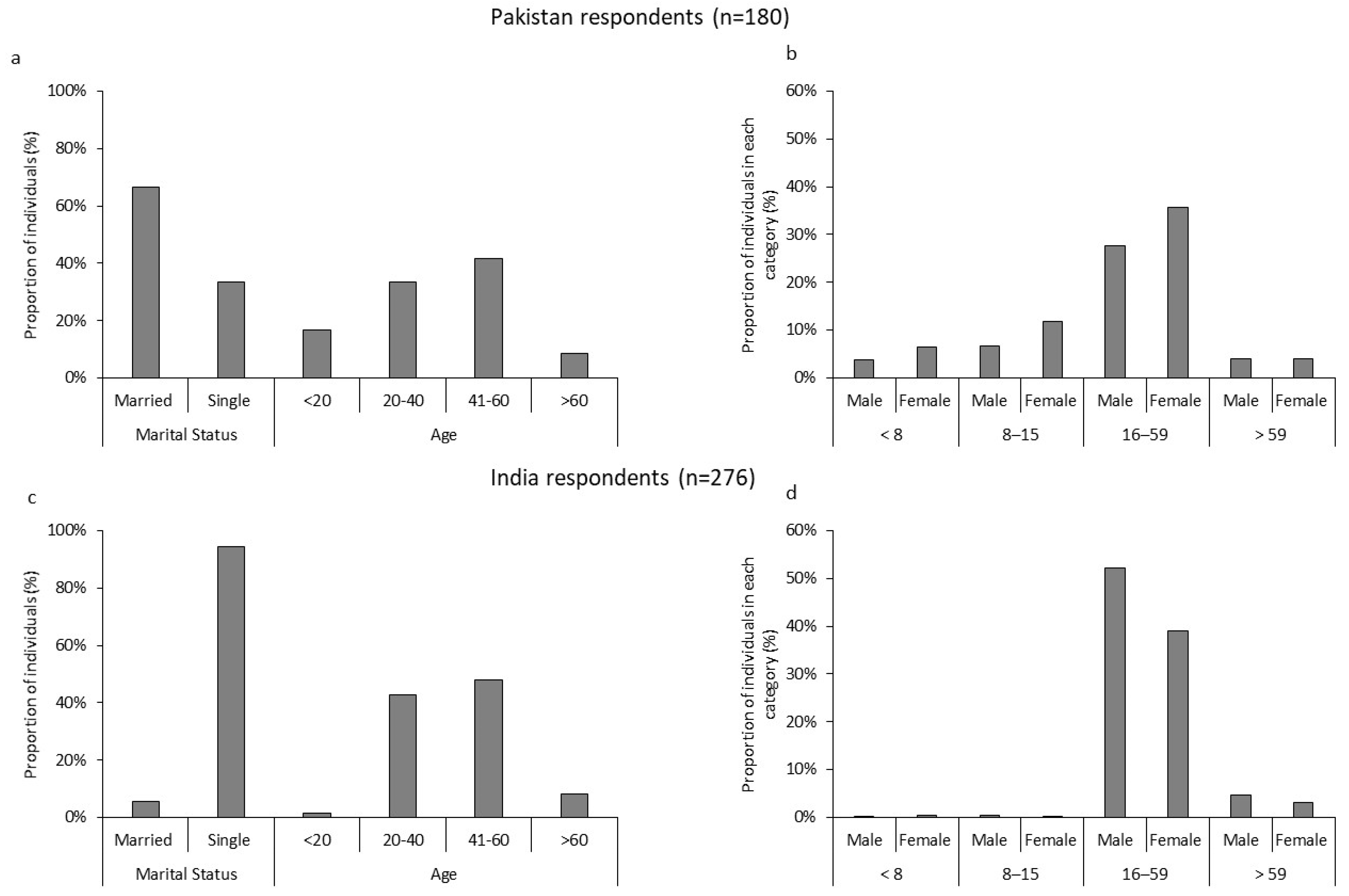

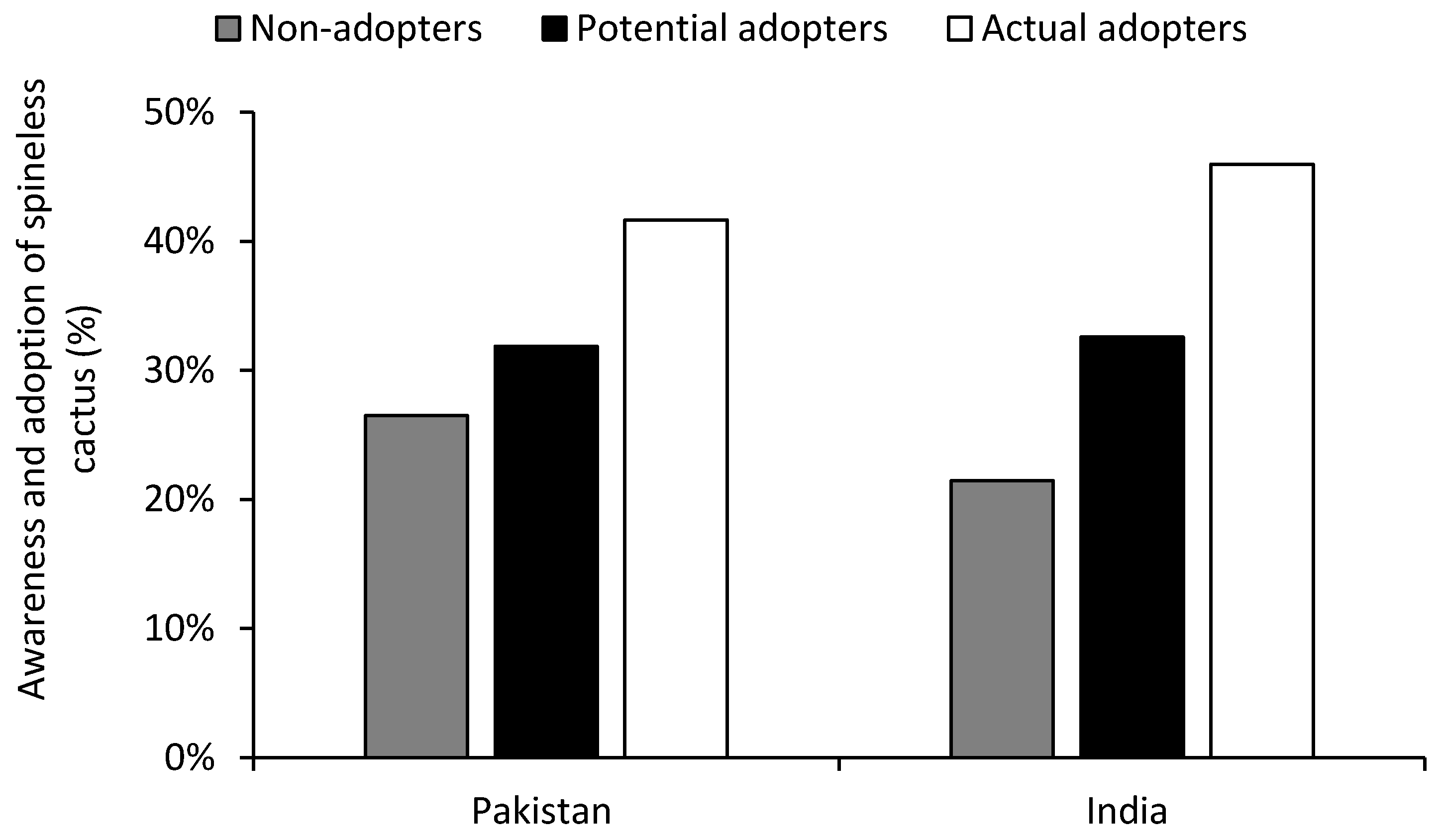
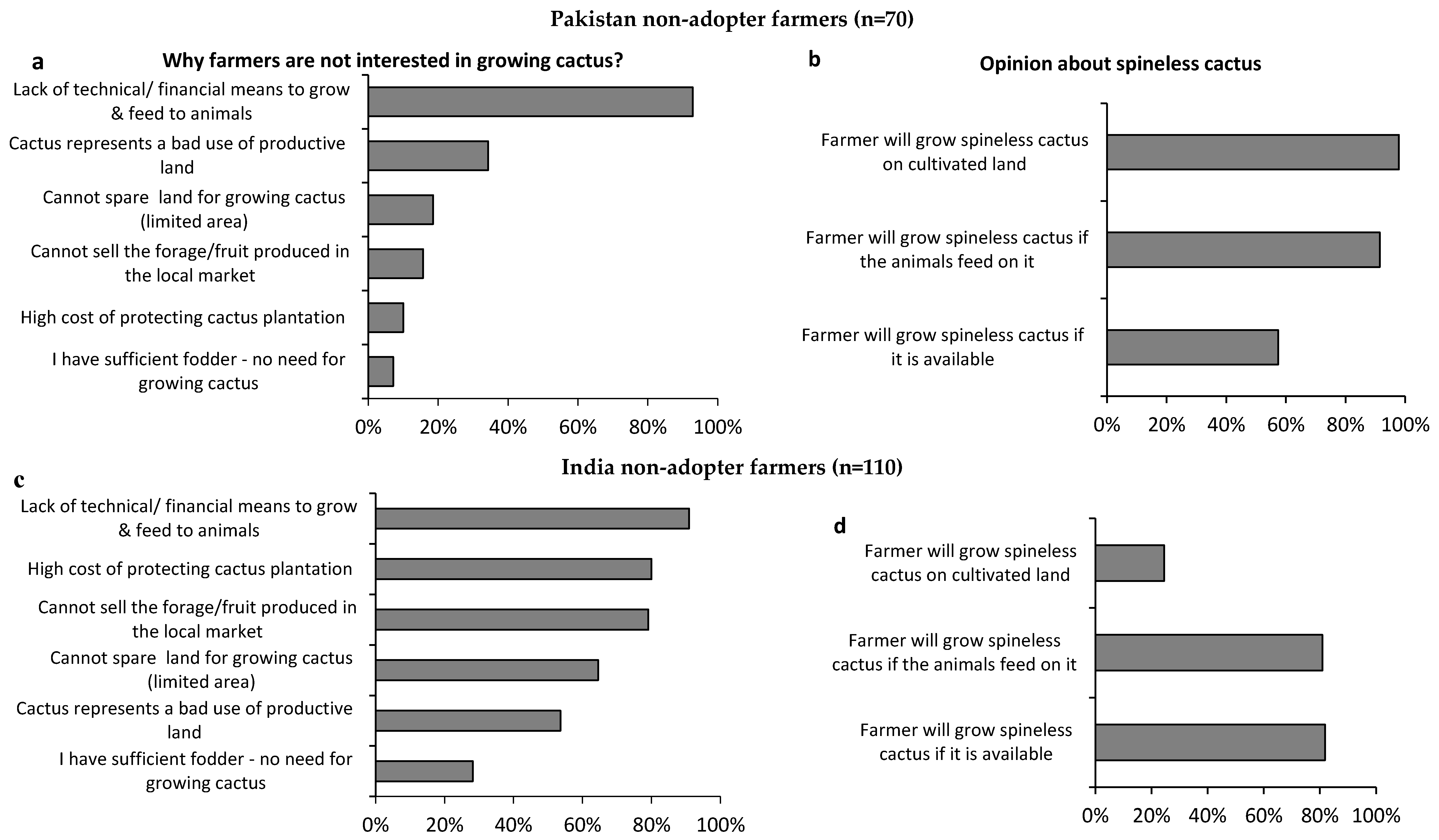
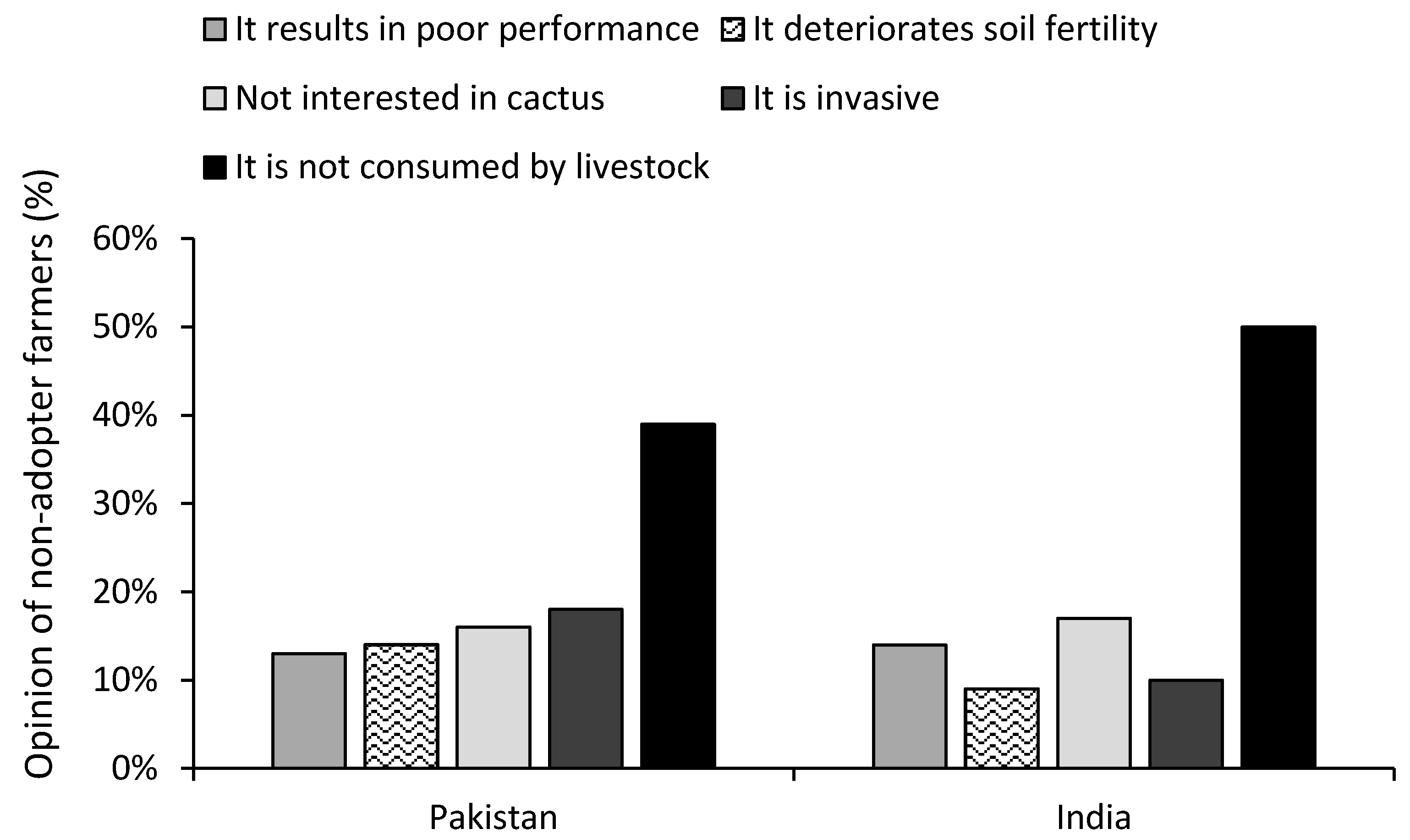
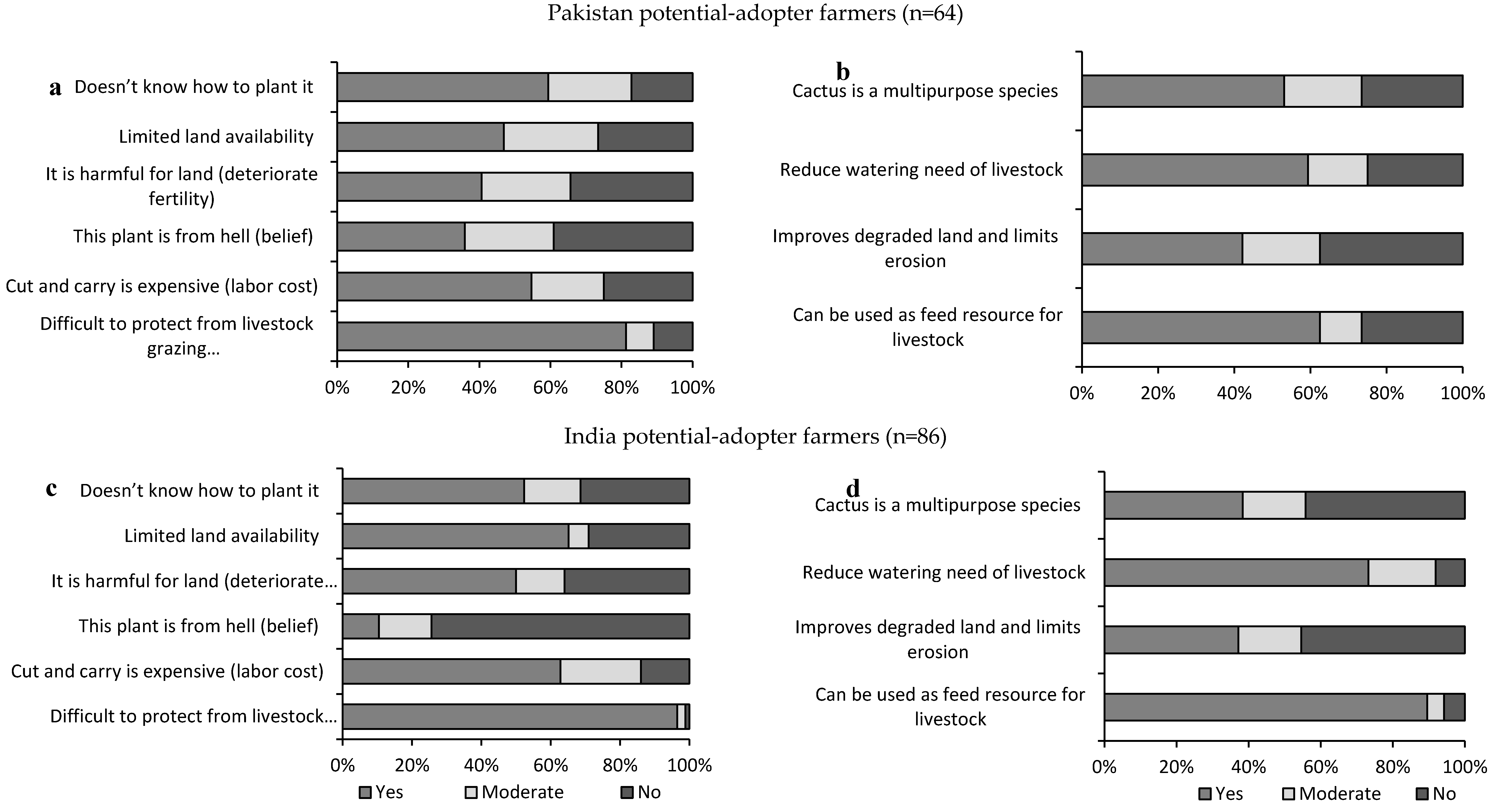
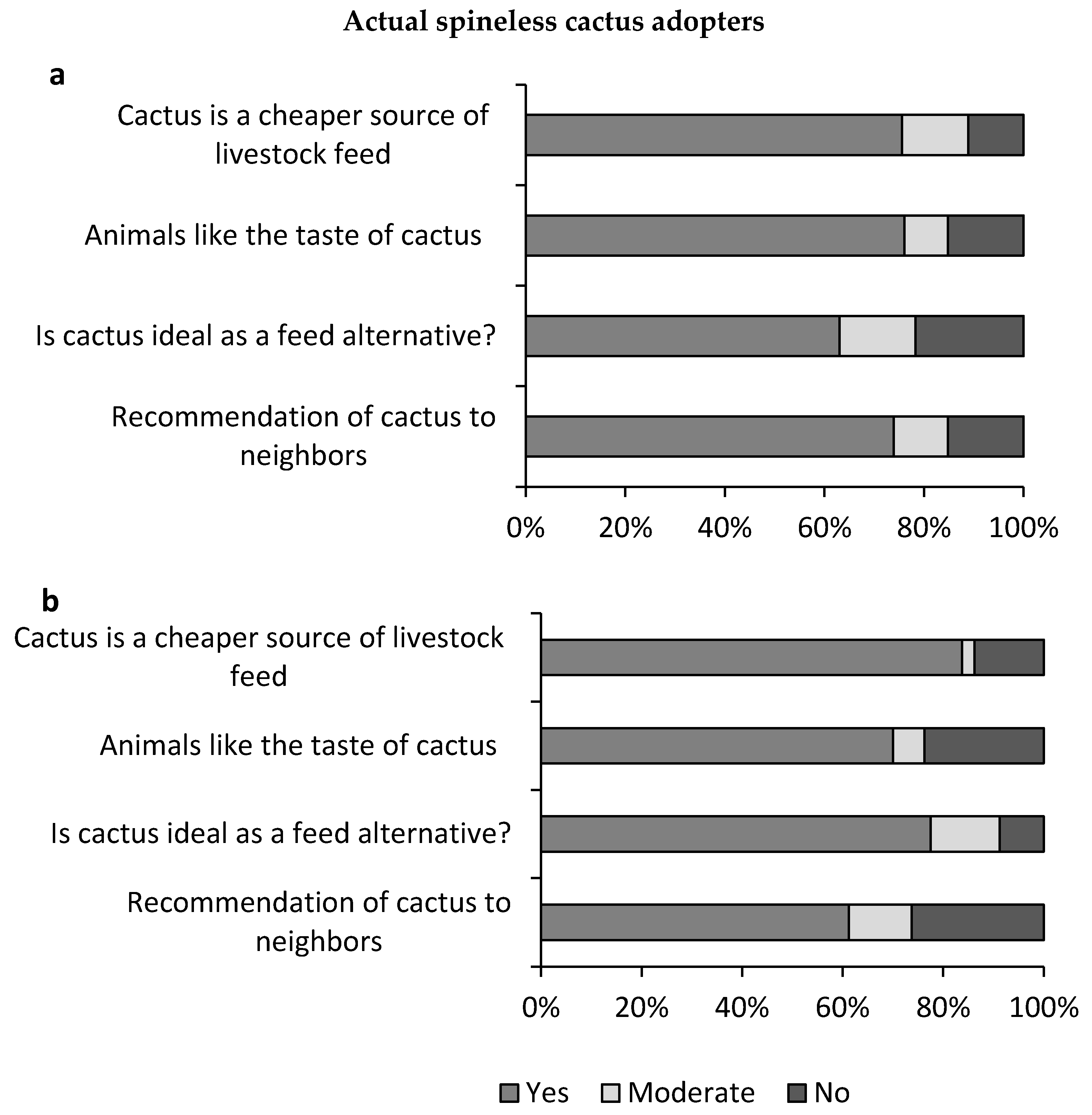
© 2018 by the authors. Licensee MDPI, Basel, Switzerland. This article is an open access article distributed under the terms and conditions of the Creative Commons Attribution (CC BY) license (http://creativecommons.org/licenses/by/4.0/).
Share and Cite
Louhaichi, M.; Kumar, S.; Tiwari, S.; Islam, M.; Hassan, S.; Yadav, O.P.; Dayal, D.; Peter Moyo, H.; Dev, R.; Sarker, A. Adoption and Utilization of Cactus Pear in South Asia—Smallholder Farmers’ Perceptions. Sustainability 2018, 10, 3625. https://doi.org/10.3390/su10103625
Louhaichi M, Kumar S, Tiwari S, Islam M, Hassan S, Yadav OP, Dayal D, Peter Moyo H, Dev R, Sarker A. Adoption and Utilization of Cactus Pear in South Asia—Smallholder Farmers’ Perceptions. Sustainability. 2018; 10(10):3625. https://doi.org/10.3390/su10103625
Chicago/Turabian StyleLouhaichi, Mounir, Suresh Kumar, Sunil Tiwari, Muhammad Islam, Sawsan Hassan, Om Parkash Yadav, Devi Dayal, Hloniphani Peter Moyo, Rahul Dev, and Ashutosh Sarker. 2018. "Adoption and Utilization of Cactus Pear in South Asia—Smallholder Farmers’ Perceptions" Sustainability 10, no. 10: 3625. https://doi.org/10.3390/su10103625






